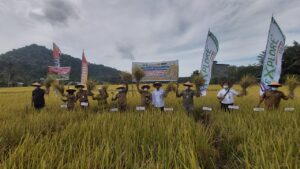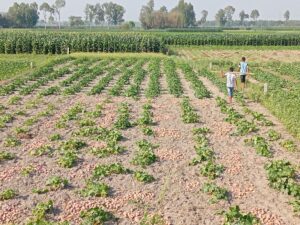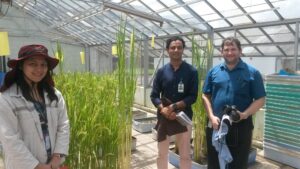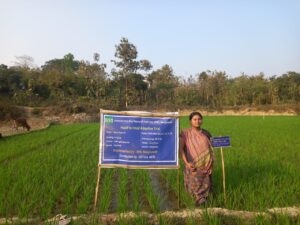
You’ve been farming for 20 years. You do things as your father did them, and his father before him. Then, one day, a scientist visits your farm. You discuss the problems that have been getting worse for the past few years. Productivity is declining and you need more fertilizer to get the same yields. You both agree that something different needs to be done. Together, you decide on a new approach.
Despite some skepticism, you allocate a significant portion of your land to a trial. But, early in the season, this experiment is looking disastrous. Your crop looks terrible. Your neighbors tell you you’re crazy and laugh at you. You seriously consider plowing the whole field under.
Now jump ahead to harvest time. That same plot of land is now admired by your neighbors as one of the best in the area. The other farmers are lining up to try the same thing in their fields next season. On top of that, you’ve saved money and helped the environment.
Conservation agriculture, as this new approach is known, is still young. We won’t know for a few years yet whether it lives up to its promise.
Right now, though, that promise is exciting. And, make no mistake—conservation agriculture could be very important indeed. This isn’t about niche farming to supplement the way things have always been done. This is about feeding a nation.
 Agriculture in India is currently at a crossroads. In many areas—especially on the most productive farms in the rice-wheat belt of the Indo-Gangetic Plains in the country’s northwest—decades of conventional farming have begun to take their toll. Years of the intensive irrigation required to grow rice have sucked the water table down, and it is dropping further each year.
Agriculture in India is currently at a crossroads. In many areas—especially on the most productive farms in the rice-wheat belt of the Indo-Gangetic Plains in the country’s northwest—decades of conventional farming have begun to take their toll. Years of the intensive irrigation required to grow rice have sucked the water table down, and it is dropping further each year.
On top of this, the combination of flooding the fields and the ever-increasing use of inputs, such as fertilizer, has led to sick and deteriorating soil. The situation is simply unsustainable.
“This is one of the biggest problems, although we don’t see that yet,” says J.K. Ladha, International Rice Research Institute (IRRI) representative to India and IRRI’s Rice-Wheat Coordinator. “Right now, productivity is maintained because farmers are putting in more chemical inputs. But I think it’s just a matter of time—five, ten years down the road—and we’ll really start to see the visible effects of land degradation.”
If that isn’t disheartening enough, you can add another problem to the mix. Fewer and fewer of India’s young want to farm. Growing up watching their parents work their fingers to the bone, often for little reward, has dissuaded a generation that sees a brighter future in India’s burgeoning urban economy. And, often, they have the understanding and support of their parents.
“Both my sons want to get out of farming,” explains Akhtar, a 45-year-old farmer from Kalugarhi village in the northwestern state of Uttar Pradesh. “My land is so small, I don’t make profits—I can’t fulfill my children’s needs. I want them to get out. I’m not against children staying on the farm. But my land will be divided between my children—more fragmentation. This is already a problem. We should look for alternatives.”
But what are the alternatives? In the next few years, scientists and farmers will discover whether conservation agriculture is one of them. In India’s rice-wheat belt, conservation agriculture holds great potential as part of an urgent and necessary change in the way people think about agriculture. That potential is currently being assessed in an Asian Development Bank-sponsored project, Enhancing farmers’ income and livelihoods through integrated crop and resource management in the rice-wheat system in South Asia. The project, which is managed by IRRI under the leadership of Dr. Ladha, falls under the umbrella of the Rice-Wheat Consortium for the Indo-Gangetic Plains. Collaborating institutes include the International Maize and Wheat Improvement Center along with the national agricultural research and extension systems of India, Bangladesh, Nepal, and Pakistan.
One of the keys to its success is not only that it maintains or increases productivity but also that it is economically viable. If it cannot help farmers increase their incomes, it is doomed from the start. Several characteristics of conservation agriculture—such as zero-tillage and direct seeding—are likely to save farmers money (for more information on direct seeding, see The direct approach on pages 12-18 of Rice Today Vol. 5, No. 2) and, so far, farmers have achieved yields as high as or higher than those obtained by the conventional practice of transplanting seedlings into flooded fields (see table below for a description of conservation agriculture principles).
Any gains from conservation agriculture will be limited if only a few scattered farmers become converts—true success will mean wide-scale adoption across the rice wheat belt. But, with any technology, good potential is no guarantee of success. More than 20 years ago, S.K. Sharma, director of the Project Directorate for Cropping Systems Research (PDCSR) in Modipuram, Uttar Pradesh, was heralding the benefi ts of direct-seeded rice, but it was never taken up in farmers’ fields.
“There were concerns about weed management in direct-seeded rice, but now several technologies allow effective control of weeds,” says Dr. Sharma. “Further, people said you need more water for direct-seeded rice. This is a myth! By using direct-seeded rice, farmers cut water use.”
Yashpal Saharawat, a soil scientist based at the IRRI-India office in Delhi, points out the grave importance of such water savings. “In India, farmers are using underground water very fast. Currently, in Haryana’s Karnal region, for example, the water table is dropping at around 1 meter per year. But farmers using direct seeding in this region are reducing their water use by around 25%.”
When Dr. Sharma first championed direct seeding, it was in some ways ahead of its time. The ideas were good but the machine technologies that would make it attractive to farmers were not available. That is no longer the case. Recent advances in machinery, along with growing shortages of labor and water and concerted research and technology dissemination efforts, mean the time is ripe for a fresh approach.
According to R.K. Gupta, the regional facilitator of the Rice-Wheat Consortium, machinery has a key role to play if conservation agriculture is to succeed on a wide scale.
“Recently developed machines allow more precise seeding,” explains Dr. Gupta. “Seeders are now available that can meter the seed rate and simultaneously apply fertilizer. Such precision allows farmers to reduce the amount of seed and fertilizer they use and so save money.”
The new seeders can also plow through the residue of the previous crop. The rotor disk drill, for example, can seed through up to 7 tons per hectare of loose residue. This offers two signifi cant advantages. First, it allows farmers to leave their fields untilled, resulting in a big savings of labor.
M.L. Jat, senior agronomist at PDCSR, says that through reduced labor—using traditional methods, farmers plow at least 10 times—zerotillage alone can save farmers 3,000 rupees (US$65) per acre (0.4 hectare). Yields are more or less the same as for conventional tillage, but even where they are slightly less, farmers win economically.
The second big advantage of zero-tillage is that farmers can leave the residue of the preceding crop in the field. That residue can then act as mulch, providing the soil with moisture and nutrients, and suppressing weed growth. And, as a double bonus, farmers no longer need to burn the residue, a practice that can harm the environment as well as soil and human health.
“We’ve developed some very good machines that can actually pick up the straw and then, after drilling the seed and putting fertilizer into place, throw the straw back for mulch,” says Dr. Ladha. “If those machines become popular, then we are really into the conservation agriculture concept.”
One of the reasons for tilling the land is to ensure that the soil is moist enough for germination. So why is zero-tillage, combined with direct seeding, now possible? The answer, again, lies in the availability of appropriate machinery. Older seed drills opened large furrows of 7.5–10 cm. If you used these to direct-seed an untilled field, the seeds would quickly dry out. The new, precise machines leave much smaller furrows, thereby eliminating this risk.










